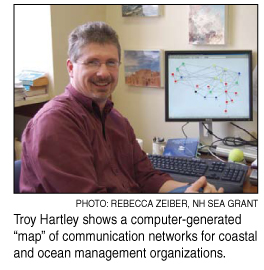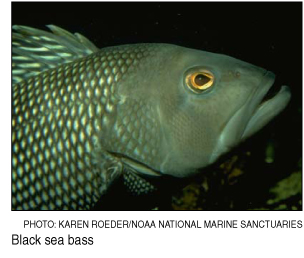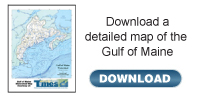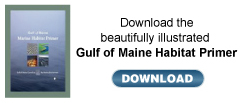In the News
Mapping communication flow for coastal managers
 A University of New Hampshire (UNH) researcher is studying the patterns of communication within and between local and regional organizations. A University of New Hampshire (UNH) researcher is studying the patterns of communication within and between local and regional organizations.
Troy Hartley, a UNH research assistant professor, was motivated by the U.S. Commission on Ocean Policy report that indicated effective coastal and ocean management is inhibited by a lack of communication, coordination and a sense of partnership. Hartley is looking at the communication networks for projects undertaken by the Atlantic Marine Fisheries Commission, the New England Fisheries Management Council, the NH Coastal Program and Cape Breton Island in Nova Scotia.
Hartley used interviews and surveys to measure communication patterns among individuals within these entities and projects. The frequency and directional flow of information within and between the key individuals, such as project coordinators, scientists and decision-makers, were then “mapped” using the computer program Inflow.
“Communication ‘maps’ make sense to people,” Hartley said in a statement. “But we will struggle finding the best ways that people can work together, communicate and coordinate effectively on a regional scale. We need to get better at that for regional integrated coastal and ocean management to become a reality.”
[ back to top ]
*Web only content*
Growing black sea bass using aquaculture
 Black sea bass is an important fishery along the U.S. Atlantic coast, but landings have decreased in recent decades as the demand for the fish in seafood and sushi markets has risen, according to National Oceanic and Atmospheric Administration (NOAA) scientists who recently found promising results when they evaluated black sea bass for commercial aquaculture. Black sea bass is an important fishery along the U.S. Atlantic coast, but landings have decreased in recent decades as the demand for the fish in seafood and sushi markets has risen, according to National Oceanic and Atmospheric Administration (NOAA) scientists who recently found promising results when they evaluated black sea bass for commercial aquaculture.
After two separate culture trials over a period of four years at the NOAA National Marine Fisheries Service lab in Milford, Connecticut, fisheries biologists found that sea bass can be grown from larvae to adults in recirculating aquaculture systems (RAS), eating a diet of commercial pellet feeds.
“Black sea bass are a slow-growing fish in the wild, but show great promise as an aquaculture species because of its rapid growth in RAS,” study leader Dean Perry said in a statement. “We were able to induce spawning and successfully culture black sea bass to adults, and had bass attain weights in under two years that take wild stocks three years or more to achieve.”
Perry and his colleagues found that the nutritional composition of the feeds used is important. Bass may need different feeds at different life stages to get the best growth in the least amount of time. RAS temperature, salinity and alkalinity levels also were found to affect growth rates.
Black sea bass range from Cape Cod to Florida but are most abundant off the Mid-Atlantic coast. All black sea bass are hermaphrodites, beginning life as females and then changing into males generally between two and five years of age. Adults migrate offshore and overwinter in deep waters, returning in the spring to shallower waters.
While optimistic about their results, Perry and his colleagues say future aquaculture research efforts should look at the factors that control growth, investigating optimal culture temperatures, lighting conditions, reproductive physiology and the nutritional requirements of various life stages of black sea bass.
For more information: [pdf file]
Gender-bending black sea bass stump scientists
 [ back to top ] [ back to top ]
*Web only content*
Rivers play role in removing nitrogen
Tiny organisms play a powerful role in removing nitrate, a form of nitrogen pollution caused by human activity, in streams, according to a study by a team led by Oak Ridge National Laboratory in Tennessee and published in Nature.
In the first phase of the study, researchers added small amounts of an uncommon non-radioactive isotope of nitrogen to 72 streams across the United States and Puerto Rico. Using this tracer, the team aimed to measure how far downstream the nitrate traveled and how it was removed from water.
"We found that the nitrate was filtered from stream water by tiny organisms such as algae, fungi and bacteria," Patrick Mulholland, lead author of the study and a member of Oak Ridge National Laboratory's Environmental Sciences Division, said in a statement.
The researchers also found that a considerable amount of nitrate was removed from streams by a bacterially mediated process known as denitrification, which converts nitrate to nitrogen gas. The gas then escapes harmlessly to the atmosphere, Mulholland said.
In the second phase of the study, the scientists developed a model to study nitrate removal from water within river networks. These networks develop as small streams flow into larger streams and rivers.
"Our model showed that the entire stream network is important in removing pollution from stream water," Mulholland said. "In addition, the effectiveness of streams to remove nitrate was greatest if the streams were not overloaded by pollutants such as fertilizers and wastes from human activities."
The largest removal occurred when nitrate entered small healthy streams and traveled throughout the network before reaching large rivers. The scientists concluded from their research that streams and rivers are effective filters that can help prevent nitrate pollution from reaching lakes and the coastal waters where this type of pollution can cause noxious algal blooms and lead to oxygen depletion and death of fish and shellfish. [more information]
[ back to top ]
*Web only content*
Underwater microscope helps prevent shellfish poisoning
An automated, underwater cell analyzer developed at the Woods Hole Oceanographic Institution (WHOI) in Massachusetts recently helped researchers and coastal managers detect a bloom of harmful marine algae in the Gulf of Mexico and prevent human consumption of tainted shellfish. Working with Rob Olson and Heidi Sosik—plankton biologists and instrument developers at WHOI—biological oceanographer Lisa Campbell of Texas A&M University used their Imaging FlowCytobot instrument to detect a substantial increase in the abundance of the algae Dinophysis acuminata in the waters of Port Aransas, Texas.
Dinophysis acuminata produces okadaic acid, a toxin that accumulates in shellfish tissues and can cause diarrhetic shellfish poisoning (DSP) in humans. DSP is not life-threatening, but symptoms include nausea, cramping, vomiting and diarrhea. Cooking does not destroy the toxin in the shellfish.
The Imaging FlowCytobot, which is automated and submersible, counts microscopic plants in the water and photographs them. The images and data are relayed back to a shore-based laboratory, where specially developed software automatically classifies the plankton into taxonomic groups.
The bloom and subsequent warning occurred just days before the Fulton Oysterfest, a major shellfish festival in the region this spring.
“This is exactly what an early warning system should be,” said Campbell. “It should detect a bloom before people get sick. So often, we don’t figure out that there is a bloom until people are ill, which is too late.” [more information]
Building an Automated Underwater Microscope
[ back to top ]
*Web only content*
Researchers see potentially significant 2008 red tide season
The end of April usually brings the first signs of harmful algae in New England waters, and this year, researchers from the Woods Hole Oceanographic Institution (WHOI) and North Carolina State University (NC State) are preparing for a potentially big bloom.
A combination of abundant beds of algal seeds and excess winter precipitation have set the stage for a harmful algal bloom similar to the historic red tide of 2005, according to the researchers. The 2005 bloom shut down shellfish beds from the Bay of Fundy to Martha’s Vineyard for several months and caused an estimated $50 million in losses to the Massachusetts shellfish industry alone.
The research team—led by WHOI senior scientists Don Anderson and Dennis McGillicuddy and physical oceanographer Ruoying He of NC State—is several years into the development of a computer model to predict the intensity and location of blooms of the toxic algae Alexandrium fundyense in the Gulf of Maine. Though the scientists are reluctant to make an official “forecast” until they can further test their models, colleagues in coastal management and fisheries believe the seasonal forecasting model can already serve as a useful tool for preparing the seafood industry for contingencies.
“With advance warning of a potentially troublesome year for algae, shellfish farmers and fishermen might shift the timing of their harvest or postpone plans for expansion of aquaculture beds,” Anderson, director of the WHOI Coastal Ocean Institute, said in a statement. “Restaurants might make contingency plans for supplies of seafood during the summer, and state agencies can ensure they have adequate staff for the significant monitoring efforts that might be required to protect public health and the shellfish industry.”
Seeds or “cysts” of A. fundyense naturally germinate and turn into swimming cells that rise from the seafloor around April 1 of each year. By the end of April, cells usually begin to appear in large numbers in the waters off coastal Maine. The algae are notorious for producing a toxin that accumulates in clams, mussels, and other shellfish and can cause paralytic shellfish poisoning (PSP) in humans who consume them.
According to a seafloor survey conducted in the fall of 2007 by Anderson’s team, the number of Alexandrium cysts is more than 30 percent higher than what was observed in the sediments prior to the historic bloom of 2005. The seed beds were especially rich in mid-coast Maine, origin of many of the cells that affect western Maine, New Hampshire and Massachusetts.
“Our hypothesis is that cyst abundance and the weather determines the bloom season,” said McGillicuddy, a biological oceanographer in the WHOI Department of Applied Ocean Physics and Engineering.
The research team has run its computer model through four scenarios, using the predominant wind patterns from each year since 2004. Toxicity levels during those years have ranged from little to nothing in the western Gulf of Maine (2004 and 2007), to extremely high levels (2005 and 2006). Blooms were worst for scenarios in which the spring weather was dominated by strong northeast winds, which tend to drive Alexandrium cells toward the southern New England coast. When southwesterlies dominated, the algae tend to stay offshore. Even when there are a lot of cells and toxicity, the effect can be confined to offshore waters. [more information]
Related Links
Building a Computer Model to Forecast Red Tides
GOMTOX
NOAA Harmful Algal Blooms page
WHOI Harmful Algae: Red Tide page
Center for Sponsored Coastal Ocean Research
Seeing Red in New England Waters
[ back to top ]
|








